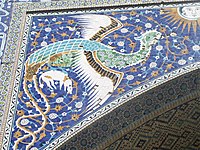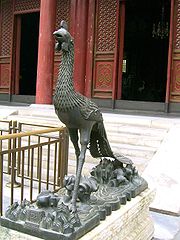Rabu, 05 Agustus 2009
mythology
A phoenix is a mythical bird with a colourful plumage and a tail of gold and scarlet (or purple, blue, and green according to some legends). It has a 500 to 1,000 year life-cycle, near the end of which it builds itself a nest of myrrh twigs that then ignites; both nest and bird burn fiercely and are reduced to ashes, from which a new, young phoenix or phoenix egg arises, reborn anew to live again. The new phoenix is destined to live as long as its old self. In some stories, the new phoenix embalms the ashes of its old self in an egg made of myrrh and deposits it in the Egyptian city of Heliopolis (sun city in Greek).
wikipedia
History
Let us consider that wonderful sign [of the resurrection] which takes place in Eastern lands, that is, in Arabia and the countries round about. There is a certain bird which is called a phoenix. This is the only one of its kind, and lives five hundred years. And when the time of its dissolution draws near that it must die, it builds itself a nest of frankincense, and myrrh, and other spices, into which, when the time is fulfilled, it enters and dies. But as the flesh decays a certain kind of worm is produced, which, being nourished by the juices of the dead bird, brings forth feathers. Then, when it has acquired strength, it takes up that nest in which are the bones of its parent, and bearing these it passes from the land of Arabia into Egypt, to the city called Heliopolis. And, in open day, flying in the sight of all men, it places them on the altar of the sun, and having done this, hastens back to its former abode. The priests then inspect the registers of the dates, and find that it has returned exactly as the five hundredth year was completed.
Michael W. Holmes points out that early Christian writers justified their use of this myth because the word appears in Psalm 92:12 [LXX Psalm 91:13], but in that passage it actually refers to a palm tree, not a mythological bird.However, it was the flourishing of Christian Hebraist interpretations of Job 29:18 that brought the Joban phoenix to life for Christian readers of the seventeenth century. At the heart of these interpretations is the proliferation of richly complementary meanings that turn upon three translations of the word chol (חול) — as phoenix, palm tree, or sand — in Job 29:18.
In a critical edition of I Clement, Lake noted that "the same story, with variations, is found in Herodotus (ii. 73), Pliny (Nat. Hist. x.2), etc."
Originally, the phoenix was identified by the Egyptians as a stork or heron-like bird called a benu, known from the Book of the Dead and other Egyptian texts as one of the sacred symbols of worship at Heliopolis, closely associated with the rising sun and the Egyptian sun-god Ra.
The Greeks identified it with their own word phoenix φοίνιξ, meaning the color purple-red or crimson (cf. Phoenicia). They and the Romans subsequently pictured the bird more like a peacock or an eagle. According to the Greeks the phoenix lived in Phoenicia next to a well. At dawn, it bathed in the water of the well, and the Greek sun-god Helios stopped his chariot (the sun) in order to listen to its song. Featured in the painting Heracles Strangles Snakes (House of the Vettii, Pompeii Italy) as Zeus, the king of the gods.
One inspiration that has been suggested for the Egyptian phoenix is the flamingo of East Africa. This bright pink or white bird nests on salt flats that are too hot for its eggs or chicks to survive; it builds a mound several inches tall and large enough to support its egg, which it lays in that marginally cooler location. The convection currents around these mounds resembles the turbulence of a flame. In zoology, flamingos are part of the family Phoenicopteridae, from the generic name Phoenicopterus or "phoenix-winged."
"Phoenix" is also the English-language name given to the most important bird in Chinese mythology, the fenghuang, with its own set of characteristics and symbolic meanings.
wikipedia
Related usage
In Persian mythology, Simurgh, (Persian: سيمرغ, Middle Persian: senmurv) was a winged, bird-like creature that was very large and extremely ancient. The Simurgh appears in many Iranian literary classics such as Farid ud-Din Attar's Conference of the Birds as instructor and birds leader, and in Ferdowsi's epic Shahnameh (The Book of Kings); Simurgh raised up and cherished Zaal or Zal, father of Rostam.
The phoenix the central figure in Lebanese ancient and modern cultures, as Lebanese are descendants of the Phoenicians and often claim themselves sons of the Phoenix.Lebanon, and Beirut particularly, is often depicted symbolically as a phoenix bird having been destroyed and rebuilt 7 times during its long history.
In China, Fenghuang ("鳳凰") is a mythical bird superficially similar to the phoenix. It is the second most-respected legendary creature (second to the dragon), largely used to represent the empress and females. The phoenix is the leader of birds.
In Japan, the phoenix is called hō-ō(kanji:"鳳凰") or fushichō (不死鳥?), literally "Immortal Bird".
In Russian folklore, the phoenix appears as the Zhar-Ptitsa (Жар-Птица), or firebird, subject of the famous 1910 ballet score by Igor Stravinsky. The phoenix was featured in the flags of Alexander Ypsilantis and of many other captains during the Greek Revolution, symbolizing Greece's rebirth, and was chosen by John Capodistria (1828-1832). In addition, the first modern Greek currency bore the name of phoenix. Despite being replaced by a royal Coat of Arms, it remained a popular symbol, and was used again in the 1930s by the Second Hellenic Republic. However, its use by the military junta of 1967-1974 made it extremely unpopular, and it has almost disappeared from use after 1974, with the notable exception of the Greek Order of the Phoenix). It was introduced by Johann Bayer in 1603.
wikipedia

